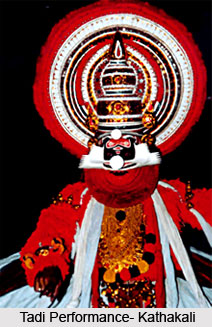 Tadi in Kathakali have three classifications - the red, the black and the white. Each tadi or beard has a significance attached to it. The beard types describe the character type too. The red beard is for the evil character most involved in destructive deeds. The basic colour scheme of the face is red. The upper portion of the face is painted black and the lower portion is painted red. The eyes have a square patch of black collyrium giving them a frightening look.
Tadi in Kathakali have three classifications - the red, the black and the white. Each tadi or beard has a significance attached to it. The beard types describe the character type too. The red beard is for the evil character most involved in destructive deeds. The basic colour scheme of the face is red. The upper portion of the face is painted black and the lower portion is painted red. The eyes have a square patch of black collyrium giving them a frightening look.
The white paste also called chutti is not applied along the natural contours of the jaw-bone. The paper cut-outs are square and put out from the line of the nose horizontally on either side of the face. This, along with the elongation of the chin by a flat false beard, gives these characters a very threatening appearance. There are two fangs protruding from the lips. They cry and scream thereby creating an atmosphere of the nether world on the stage.
The black beards indicate the aborigines and the off-beat characters like the Kirata. The basic make-up here is black. On this, there are many designs in white and red. The black beards are also associated with the Kari characters.
The white beard also known as veluppu Tadi indicate the third type of half-human gods like Lord Hanuman. The basic make-up here is white. These characters are gentle although they can assume violent forms. Characters like the Lion-God or Narasimha have a make up of a different type. The basic make-up of such characters is yellow, representing Adbhuta or wonder. In Kathakali, this is known as a variation of the white beard. This make-up is a class by itself and one of the most effective make-ups of the Kathakali dance-drama.
Other types of characters in Kathakali do not have such elaborate make-up. There is only one basic make-up for them, the pink on the face without any attempt at masking. These are known as the minukku. Women, Brahmins, messengers, rishis, all appear in ordinary costumes.



















